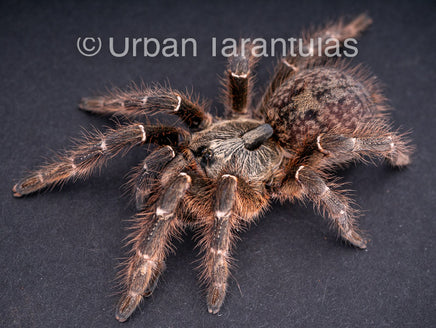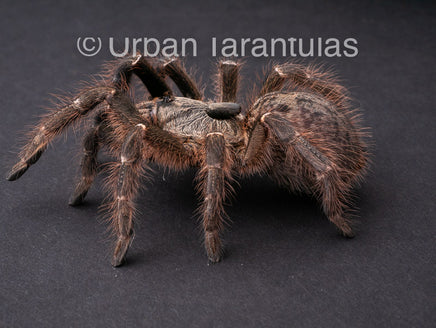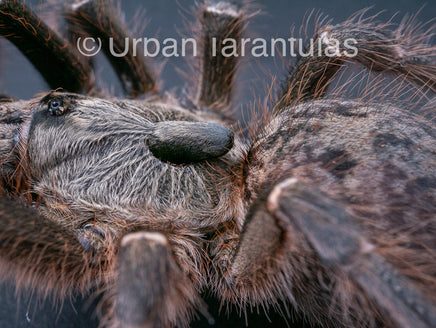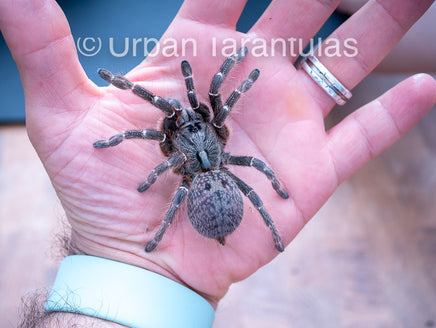Meet the Ceratogyrus darlingi, commonly known as the Rear-horned Baboon Tarantula, a remarkable creature that stands out in the tarantula community. This species is well-known for its intriguing characteristic: a pronounced horn protruding from its carapace, which varies in size among individuals. Originating from the savannahs and scrublands of Southern Africa, this tarantula's striking appearance and behavior make it a must-have for any collector or enthusiast looking for something out of the ordinary.
Care Details:
- Temperature: The ideal range for the Ceratogyrus darlingi, like most tarantulas, is between 75 to 85°F (24 to 29°C). This range encourages healthy eating habits, growth, and molting cycles, making tarantula care a manageable task.
- Humidity: The Ceratogyrus darlingi thrives in a humidity level of around 60-70%. While water dishes are not necessary, including one poses no harm. Personally, I opt not to use them, simplifying care and maintenance.
- Housing: As a terrestrial/hybrid species, young Ceratogyrus darlingi can be comfortably housed in a 1 oz to 4 oz deli container with needle-made ventilation holes. For larger specimens, a terrarium 2 to 3 times their size will suffice. Remember, I offer a free deli container or small enclosure for babies with your order, but you must specify this request at checkout to receive it.
Diet:
I ensure a diverse diet for my Ceratogyrus darlingi, consisting of crickets and various cockroaches, including Dubia, Red-runner, Lobster, and Madagascar hissing roaches. For juveniles, smaller prey like baby crickets and roaches are ideal. It's fine if you have access to only one type of feeder insect. If the prey is too large, simply crush its head and leave it in the enclosure for your tarantula to handle. Always remove uneaten food to prevent mold growth. For a treat, consider offering a pinky mouse or hopper, but do so sparingly to avoid nutritional imbalances.
In-depth facts:
- Latin name: Ceratogyrus darlingi
- Common name: Rear-horned Baboon Tarantula
- Locale: Native to the savannahs and scrublands of Southern Africa
- Category: Terrestrial, hybrid
- Type: Old World
- Size: Females can grow up to 5-6 inches, with males slightly smaller
- Urticating hairs: No, this species does not have urticating hairs
- Growth rate: Medium to fast, reaching maturity in a few years
- Life span: Females can live up to 12 years, while males have a shorter lifespan of around 3-4 years
- Recommended levels: Suitable for keepers that love unique species. There are very few species with horn on their carapace, and this one has a rather pronounced one that is super cool.
Stay Connected:
- Instagram: I'm most active here.
- YouTube: Check out my channel for care and education videos.
- Facebook: Here you can find all my reviews.
- TikTok: Visit for additional content.
Safety Disclaimer:
Experiencing a tarantula bite is extremely rare, and there have been no recorded fatalities. Old World tarantulas, like the Ceratogyrus darlingi, generally have stronger venom than their New World counterparts. Approach with respect and understanding. If bitten, stay calm; discomfort typically subsides quickly, though symptoms can last longer with more potent venom. Larger tarantulas have more venom. I cannot assume responsibility for bites. Handle tarantulas at your own risk. In over a decade, I've been bitten once, with symptoms lasting a week.
The Rear-horned Baboon Tarantula is not just a pet; it's a journey into the rich tapestry of nature's marvels. Its care and maintenance are straightforward, offering an enriching experience for those willing to delve into the world of tarantulas.







